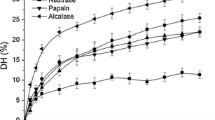Abstract
Increasing the applications of industrial by-products is of great interest. Therefore, in the present study, sunflower oil cake from a local oil manufacturing company was used to obtain soluble protein concentrates and isolates with different content of phenolic compounds. All the extraction procedures evaluated resulted in concentrates and isolates with water solubility higher than 75% but with different chemical composition, color and physicochemical properties (i.e. surface hydrophobicity, thermal stability, and polypeptide composition). Since no extraction process led to a complete extraction of phenolic compounds, all the products exhibited antioxidant activity, which depended on the concentration of such compounds. Phenolic compounds give a dark color to sunflower protein concentrates and isolates; nevertheless their final color tone was more dependent on the conditions used in the preparation process than on the amount of phenolic compounds in the product. The results demonstrate the value of sunflower industrial oil cake as a source of proteins with high water solubility, good physicochemical properties and antioxidant activity.





Similar content being viewed by others
References
Moure A, Sineiro J, Domínguez H, Parajó JC (2006) Functionality of oilseed protein products: a review. Food Res Int 39:945–963
González-Pérez S, Vereijken JM (2008) Sunflower proteins: overview of their physicochemical, structural and functional properties. J Sci Food Agric 87:2172–2191
Argentinean National Food Direction (SAGPyA) http://www.alimentosargentinos.gov.ar. Accessed June 2010
Prasad DT (1990) Proteins of the phenolic extracted sunflower meal: I. Simple method for removal of polyphenolic components and characteristics of salt soluble proteins. LWT 23:229–235
Pringent SVE, Gruppen H, Visser AJWG, van Koningsveld GA, De Jong GAH, Voragen AGJ (2003) Effects of non-covalent interactions with 5-O-caffeoyl quinic acid (Chlorogenic Acid) on the heat denaturation and solubility of globular proteins. J Agric Food Chem 51:5088–5095
González-Pérez S, Merck KB, Vereijken JM, Van Koningsveld GA, Gruppen H, Voragen AGJ (2002) Isolation and characterization of undenatured chlorogenic acid-free sunflower (Helianthus annuus) proteins. J Agric Food Chem 50:1713–1719
Rice-Evans CA, Miller NJ, Paganga G (1995) Structure-antioxidant activity relationships of flavonoids and phenolic acids. Free Radic Biol Med 20:933–956
Raskin I, Ribnicky DM, Komarnytsky S, Illic N, Poukev A, Bortsjuk N, Brinker A, Moreno D, Ripoll C, Yakoby N, O′Neil J, Cornwell T, Fridlender B (2002) Plants and human health in the twenty-first century. Trends Biotechnol 20:522–531
AOAC (1995) Official Methods of Analysis of AOAC International, 16th edn. AOAC International: Gaithersburg, MD
Moores RG, McDermott DL, Wood TR (1948) Determination of chlorogenic acid in coffee. Anal Chem 20:620–624
AOCS (1995) Official Methods and Recommended Practices of the AOCS, 5th edn. AOCS, Champaign
Molina MI, Petruccelli S, Añón MC (2004) Effect of pH and ionic strength modifications on thermal denaturation of the 11s globulin of sunflower (Helianthus annuus). J Agric Food Chem 52:6023–6029
Laemmli UK (1970) Cleavage of structural proteins during the assembly of the head of bacteriophage T4. Nature 227:681–685
Petruccelli S, Añón MC (1994) Relationship between the method of obtention and the structural and functional properties of soy protein isolates. 2. Surface properties. J Agric Food Chem 42:2170–2176
Bradford MM (1976) A rapid and sensitive method for the quantification of microgram quantities of protein utilizing the principle of protein-dye binding. Anal Biochem 72:248–254
Kato A, Nakai S (1980) Hydrophobicity determined by a fluorescence probe method and its correlation with surface properties of proteins. Biochim Biophys Acta 624:13–20
Re R, Pellegrini N, Proteggente A, Pannala A, Yang M, Rice-Evans CA (1999) Antioxidant activity applying an improved ABTS radical caution decolorization assay. Free Radic Biol Med 26:1231–1237
González RJ, Urquía MA (1975) Estudio del equilibrio práctico de extracción de proteínas a partir de harinas industriales de girasol. ITA UNL 1:75–80
Ayhllon-Meixueiro F, Vaca-Garcia C, Silvestre F (2000) Biodegradable films from isolate of sunflower (Helianthus annuus) proteins. J Agric Food Chem 48:3032–3036
Vioque J, Sánchez-Vioque R, Pedroche J, Yust MM, Millán F (2001) Obtención y aplicaciones de concentrados y aislados proteicos. Grasas y Aceites 52:127–131
Mendieta JR, Giudici MA, de la Canal L (2004) Occurrence of antimicrobial serin-proteinases in sunflower seeds. J Phytopathol 152:43–47
Damodaran S (1989) Interrelationship of molecular and functional properties of food proteins. Food proteins. AOCS Press, Champaign
Fujioka K, Shibamoto T (2008) Chlorogenic acid and caffeine contents in various commercial brewed coffees. Food Chem 106:217–221
Sosulski F (1979) Organoleptic and nutritional effects of phenolic compounds on oilseed protein products: a review. J Am Oil Chem Soc 56:711–715
Saeed M, Cheryan M (1988) Sunflower protein concentrates and isolates low in polyphenols and phytate. J Food Sci 53:1127–1143
Petruccelli S, Añón MC (1995) Partial reduction of soy protein isolate disulfide bonds. J Agric Food Chem 43:2001–2006
Rodríguez Patino JM, Caro AL, Rodríguez Niño MR, Mackie AR, Gunning AP, Morris VJ (2007) Some implications of nanoscience in food dispersion formulations containing phospholipids as emulsifiers. Food Chem 102:532–541
Bau HM, Mohtadi Nia DJ, Mejean L, Debry G (1983) Preparation of colorless sunflower protein products: effect of processing on physicochemical and nutritional properties. J Am Oil Chem Soc 60:1141–1148
Sripad G, Narasinga Rao MS (1987) Effect of methods to remove polyphenols from sunflower meal on the physicochemical properties of the proteins. J Agric Food Chem 35:962–967
Acknowledgments
The authors wish to thank the National Research Council (CONICET, PIP 6094) and the National Agency of Scientific and Technological Support (SECyT, PICTO 13156 and PICT 35036) of Argentina for their financial support.
Author information
Authors and Affiliations
Corresponding author
About this article
Cite this article
Salgado, P.R., Molina Ortiz, S.E., Petruccelli, S. et al. Sunflower Protein Concentrates and Isolates Prepared from Oil Cakes Have High Water Solubility and Antioxidant Capacity. J Am Oil Chem Soc 88, 351–360 (2011). https://doi.org/10.1007/s11746-010-1673-z
Received:
Revised:
Accepted:
Published:
Issue Date:
DOI: https://doi.org/10.1007/s11746-010-1673-z




